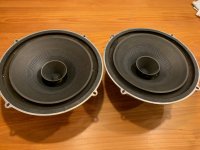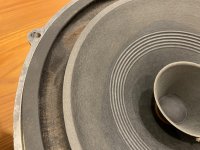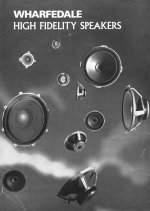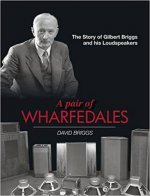The Chief Cook & Bottle Washer (CC&BW) has declared a "Spring Cleaning Emergency". In January. She says it's gotta be Springtime somewhere; says the same thing about 5 o'clock.
Translation from wife-speak: "you ARE going to sell those speakers stacked-up in the back of the bedrooms closets, RIGHT?"
The CC&BW hath spoken.
Most of the victims, I mean, fine salable guitar and hifi drivers, are easily identified, EXCEPT THESE TWO. I believe they were eBay finds at least a decade ago.
DCR is ~6.5 ohm, so likely 8 ohm. 12" nominal with semitransparent cloth surrounds. Slight voice coil rubbing, likely due to the creased surrounds canting the cones a bit. Heavy cast al-you-minium frames (I've had 7 British bosses if you could Australians; I can also say Poly-theene) marked Made in England.
No makers marks or serial numbers; those must have been on the missing magnet covers.
I BELIEVE that they are Wharfedale full range, but (a) which ones, and (b) are they worth having restored (likely a job for local speaker guy...)
In an open baffle they sound INCREDIBLY transparent and happy, so I'm leaning towards paying for restoration as the cones are unusually good.
Translation from wife-speak: "you ARE going to sell those speakers stacked-up in the back of the bedrooms closets, RIGHT?"
The CC&BW hath spoken.
Most of the victims, I mean, fine salable guitar and hifi drivers, are easily identified, EXCEPT THESE TWO. I believe they were eBay finds at least a decade ago.
DCR is ~6.5 ohm, so likely 8 ohm. 12" nominal with semitransparent cloth surrounds. Slight voice coil rubbing, likely due to the creased surrounds canting the cones a bit. Heavy cast al-you-minium frames (I've had 7 British bosses if you could Australians; I can also say Poly-theene) marked Made in England.
No makers marks or serial numbers; those must have been on the missing magnet covers.
I BELIEVE that they are Wharfedale full range, but (a) which ones, and (b) are they worth having restored (likely a job for local speaker guy...)
In an open baffle they sound INCREDIBLY transparent and happy, so I'm leaning towards paying for restoration as the cones are unusually good.
Attachments
Definitely Wharfedale, as evidenced by the basket shape,' Made in England' legend and the distinctive roll surround.
I own Wharfedale RS12DD drivers which are similar, but not identical.
I own Wharfedale RS12DD drivers which are similar, but not identical.
They shouldnt make me drool like that...lest I end up with another bedroom closet stack. I'd say Wharfy too.
I see the problem, you are likely not experience any degradation in SQ unless you force the driver to extreme excursions.
From what I see from these pictures you don't need to do anything on these drivers unless you absolutely have to drive them below ~80Hz and if you don't play music very loud, you don't have to change anything anyway.
From what I see from these pictures you don't need to do anything on these drivers unless you absolutely have to drive them below ~80Hz and if you don't play music very loud, you don't have to change anything anyway.
Wharfedale components were shipped to the USA where loudspeaker versions different to those obtainable in the UK were manufactured.
We would need to find a US Wharfedale catalogue as the drivers illustrated do not appear in the UK catalogue.
This is what the RS12DD looks like for comparison purposes.

The RS12DD looks superior to your model and is still highly prized over here.
We would need to find a US Wharfedale catalogue as the drivers illustrated do not appear in the UK catalogue.
This is what the RS12DD looks like for comparison purposes.

The RS12DD looks superior to your model and is still highly prized over here.
When mounted on a baffle, you may be able to rotate the driver to compensate for the cant and stop the slight voice coil rub.Slight voice coil rubbing, likely due to the creased surrounds canting the cones a bit.
We would need to find a US Wharfedale catalogue as the drivers illustrated do not appear in the UK catalogue.
Right you are. I scourged the UK documentation that I could find, and came to the same conclusion.
Does anybody have the remotest idea where US Wharfedale data might be had?
Buried in the closet someplace with the Amateur Radio stuff, there’s a speaker analyzer IIRC. Perhaps time to drag it out.
PS is anybody familiar with the open weave fabric surround? Seems like it isn’t an effective barrier between front and back, but there’s no sign that it was previously coated or doped or the like...
The RS12DD looks superior to your model and is still highly prized over here.
I looked carefully at your photo, and the similarities are greater than the (minor) differences.
The RS 12 DD has terminals mounted on a boss on one leg of the basket casting. That boss is present on my speakers, without the terminals of course. I think I have period-correct terminals from old HP equipment if I wanted to fake it...
They have different whizzer cones, but not THAT different.
The cloth surrounds are both concave channels, the major difference seems to be that mine are SHEIT. Can I say SHEIT? Too late...
The magnet size and aspect ratio is very similar, although the RS 12 DD still has a nice cover (although not the “shielding can” typical of Yank speakers.
I think these may be a US version of the RS 12 DD...
PS looked a pair of RS 12 DD on UK eBay, and the cloth surrounds ARE identical, albeit not the s-word.
The RS12DD looks superior to your model and is still highly prized over here.
I looked carefully at your photo, and the similarities are greater than the (minor) differences.
The RS 12 DD has terminals mounted on a boss on one leg of the basket casting. That boss is present on my speakers, without the terminals of course. I think I have period-correct terminals from old HP equipment if I wanted to fake it...
They have different whizzer cones, but not THAT different.
The cloth surrounds are both concave channels, the major difference seems to be that mine are SHEIT. Can I say SHEIT? Too late...
The magnet size and aspect ratio is very similar, although the RS 12 DD still has a nice cover (although not the “shielding can” typical of Yank speakers.
I think these may be a US version of the RS 12 DD...
In his book 'More About Loudspeakers' (1963), Gilbert Briggs states that "For maximum LF excursion without distortion, under airtight conditions, the roll surround is hard to beat and stands up well to the effects of heat and humidity." He goes on to say that the foam and cloth surrounds of the day were not airtight.PS is anybody familiar with the open weave fabric surround? Seems like it isn’t an effective barrier between front and back, but there’s no sign that it was previously coated or doped or the like...
A photograph shows the roll surrounds being dried by infra-red lamps after moulding and sealing in the factory. The photo shows circles of white cloth with the black (due to the sealant) surrounds moulded around their circumferences.
The Wharfedale 12" speaker chassis or basket is a standard size so you will see that your driver has a smaller diameter ceramic magnet than the RS12DD.The magnet size and aspect ratio is very similar, although the RS 12 DD still has a nice cover (although not the “shielding can” typical of Yank speakers.
The RS12DD magnet does not have a magnet 'cover', what you see is the mild steel back plate of the magnet assembly.
No vintage UK Wharfedale Hi-Fi speakers had concealing magnet covers - what you saw is what you got! 😉
Attachments
Good stuff, thanks for the help. Glad there's a Subject Matter Expert out there or these might end up in the Tip ("dumpster" for Yanks)
OK, so tabulating the deltas:
I know that Wharfedale made speaker "kits" once or twice in their history.
I wonder if these were "kit" speakers, USA only....
OK, so tabulating the deltas:
- magnet diameter is smaller
- whizzer cone appears to be marginally taller and narrower angle
- main cone has fewer "creases" (or whatever they are called); about HALF
- frame has the raised boss for terminals, but a Yank-style terminal strip instead
- "Wharfedale" NOT cast into the frame; I think this one is especially interesting & important. I should look to see if I can spot a mold insert where the name would normally be on the rim...
I know that Wharfedale made speaker "kits" once or twice in their history.
I wonder if these were "kit" speakers, USA only....
No 'Wharfedale' stamped anywhere on the frame? That's interesting!
My RS12DD roll surrounds are 'see through' (as are the ones I've seen in photos), but that doesn't seem to affect their performance in my aperiodic enclosures which, by definition, are 'leaky' anyway!
Some owners prefer to apply sealant to these roll surrounds in order to ensure air tightness.
I would be very cautious with the process in regard to the type of sealent used.
This product has been recommended on this forum: Speaker Repair Latex Adhesive - Professional Grade for Surrounds Cones Dust Caps and more.
This latex adhesive should be thinned with water before brushing it sparingly onto the roll surround. This dries flexible and is a benign product which will not harm the structure of the roll surround unlike some volatile compounds which are often recommended.
My RS12DD roll surrounds are 'see through' (as are the ones I've seen in photos), but that doesn't seem to affect their performance in my aperiodic enclosures which, by definition, are 'leaky' anyway!
Some owners prefer to apply sealant to these roll surrounds in order to ensure air tightness.
I would be very cautious with the process in regard to the type of sealent used.
This product has been recommended on this forum: Speaker Repair Latex Adhesive - Professional Grade for Surrounds Cones Dust Caps and more.
This latex adhesive should be thinned with water before brushing it sparingly onto the roll surround. This dries flexible and is a benign product which will not harm the structure of the roll surround unlike some volatile compounds which are often recommended.
To aid your research, I can tell you that the US agent for Wharfedale in the early 50s was British Industries Corporation (BIC).
By 1956, BIC had set up a subsidiary company, Wharfedale Audio Products, to marry locally made cabinets to drive units imported from the Idle factory in England.
At that time, BIC also assembled certain drive units from components imported from England.
By the early 60s, BIC-Wharfedale had introduced the American range of Achromatic speaker systems, the W40, W60, W70 and the W90.
https://worldradiohistory.com/hd2/I...atalogs/Allied-Catalog-1963-OCR-Page-0170.pdf
https://worldradiohistory.com/hd2/I...-IDX/IDX/60s/Audio-1961-Mar-OCR-Page-0005.pdf
(Information courtesy of 'A Pair of Wharfedales' by David Briggs; ISBN: 978-1-906715-14-4; published 2012)
Those early speakers had alnico magnets. Your ceramic magnet model appears to date from the same period as my ceramic magnet RS/12/DD which was available from 1961 till 1969.
To my knowledge, the only kit loudspeaker introduced in the UK during that period was the Unit 3 (1968) which included a cast chassis 8" bass/mid driver with ceramic magnet and from which a Super Linton could be built. This kit is not to be confused with later pressed steel chassis Linton kits.
https://worldradiohistory.com/hd2/I...less-IDX/IDX/60s/PW-1968-06-OCR-Page-0016.pdf
By 1956, BIC had set up a subsidiary company, Wharfedale Audio Products, to marry locally made cabinets to drive units imported from the Idle factory in England.
At that time, BIC also assembled certain drive units from components imported from England.
By the early 60s, BIC-Wharfedale had introduced the American range of Achromatic speaker systems, the W40, W60, W70 and the W90.
https://worldradiohistory.com/hd2/I...atalogs/Allied-Catalog-1963-OCR-Page-0170.pdf
https://worldradiohistory.com/hd2/I...-IDX/IDX/60s/Audio-1961-Mar-OCR-Page-0005.pdf
(Information courtesy of 'A Pair of Wharfedales' by David Briggs; ISBN: 978-1-906715-14-4; published 2012)
Those early speakers had alnico magnets. Your ceramic magnet model appears to date from the same period as my ceramic magnet RS/12/DD which was available from 1961 till 1969.
To my knowledge, the only kit loudspeaker introduced in the UK during that period was the Unit 3 (1968) which included a cast chassis 8" bass/mid driver with ceramic magnet and from which a Super Linton could be built. This kit is not to be confused with later pressed steel chassis Linton kits.
https://worldradiohistory.com/hd2/I...less-IDX/IDX/60s/PW-1968-06-OCR-Page-0016.pdf
Attachments
No, NO indication of the maker anywhere. No “Wharfedale” cast into frame, no EIA numbers (I think EIA is right, it’s been a while), no nothing. I would say “speakers without a country” but that’s the ONLY thing they have.
ALSO, the DCR is 6.5 ohms, indicating an 8 ohm coil, which I can’t find in any Wharfedale documentation. It is a very strange duck...
Good stuff about the surround. Left to my own devices. I probably would have used silicon (probably too dense) but latex is a great idea. Biggest problem is figuring-out how to “reform” the surround “channels”. I’m guessing that a hairdryer and gentle manipulation might work, then latex to preserve the shape.
Any thoughts on that issue?
ALSO, the DCR is 6.5 ohms, indicating an 8 ohm coil, which I can’t find in any Wharfedale documentation. It is a very strange duck...
Good stuff about the surround. Left to my own devices. I probably would have used silicon (probably too dense) but latex is a great idea. Biggest problem is figuring-out how to “reform” the surround “channels”. I’m guessing that a hairdryer and gentle manipulation might work, then latex to preserve the shape.
Any thoughts on that issue?
As valve amplification transitioned to solid state amplification, Wharfedale driver impedance transitioned for 10 - 15 ohm to 4 - 8 ohm. This transition started to take place in the late sixties, at least in the UK.
The Radio Museum describes the Unit 3 kit drivers as being 4 - 8 ohm and they date back to 1968. Then, again, the Super Lintons say 'suitable for 8 - 15 ohm'.
I've no additional thoughts on how to smooth those creases. Go carefully, with the minimum amount of tweaking to stop the voice coils rubbing. Have you tried rotating the drivers on the baffle?
The Radio Museum describes the Unit 3 kit drivers as being 4 - 8 ohm and they date back to 1968. Then, again, the Super Lintons say 'suitable for 8 - 15 ohm'.
I've no additional thoughts on how to smooth those creases. Go carefully, with the minimum amount of tweaking to stop the voice coils rubbing. Have you tried rotating the drivers on the baffle?
The cones are CANTED due to the creases; in profile view, one side of the cone is proud of the front of the speaker; should have taken a photo, and I'm 200 miles away from the shop at the moment. I'm sure the voice coil is rubbing because of the canted cone.
I will try applying a little heat VERY SLOWLY to try to soften the "dope" (or whatever it is coating the fabric) and gradually reform the surround and hopefully urge the cone back into alignment. The front face of the speaker is a pretty good gauge, I think.
THe surrounds and cones are all intact, so if the outer face of the is aligned with the face of the frame, I'm hoping that the coil will be aligned properly.
I will try applying a little heat VERY SLOWLY to try to soften the "dope" (or whatever it is coating the fabric) and gradually reform the surround and hopefully urge the cone back into alignment. The front face of the speaker is a pretty good gauge, I think.
THe surrounds and cones are all intact, so if the outer face of the is aligned with the face of the frame, I'm hoping that the coil will be aligned properly.
What you are describing is very common. I usually turn it 180º on an open baffle and use a hair dryer to assist the process.
- Home
- Loudspeakers
- Full Range
- HELP, please, ID'ing these 12" speakers





